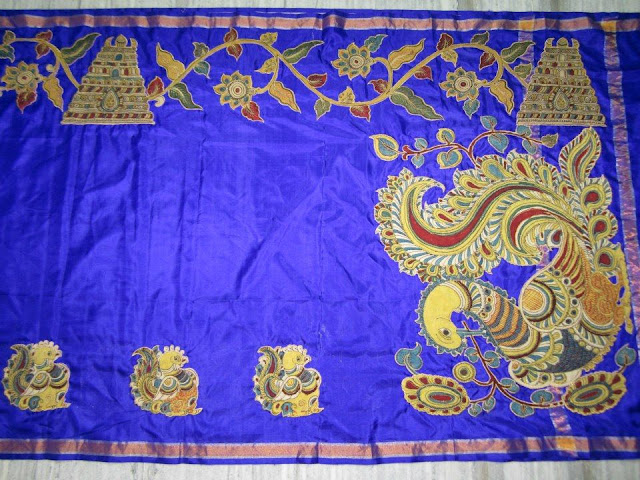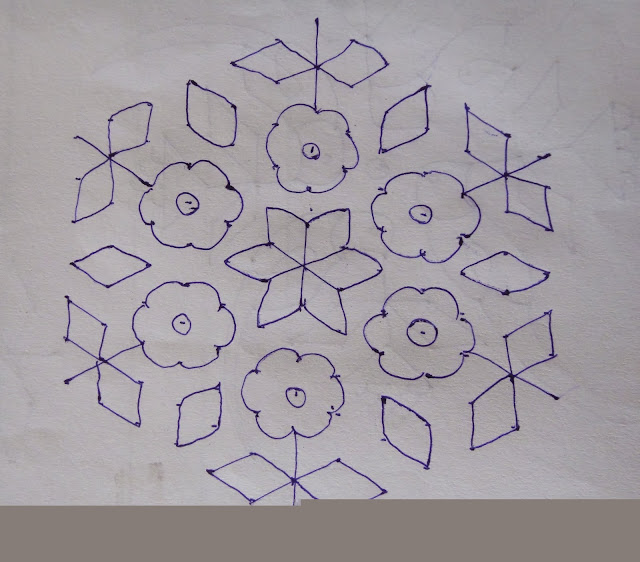
MYSORE PAINTING
|
The fall of Vijayanagara empire in 1565 AD resulted in the loss of roya patronage for traditional painters. However, Raja Wodeyar (1578 - 1617 AD) of Mysore helped rehabilitate several families of painters of the Vijayanagara School in Srirangapattana. Mysore and Tanjore traditional paintings are off shoots of the Vijayanagara school of painting. Sritattvanidhi, and illustrated manuscript compiled during the time of Raja Wodeyar, served as an instruction manual for painters. The painting technique includes gesso or applying a mixure of plaster and glue on some parts in relief on which gold foil is applied. Gold foil is used or depicting intricate details of jewellery, costumes and architectural details that fraom the deity. The details of costumes and ornamentation were in keeping with prevalent court styles. Mysore painting strikes a departure from Tanjore or Thanjavur as it borrows from Kerala murals, linearity and the application of watercolours. The gesso work in comparision to Tanjore school is low in relief. Painters still use the traditional natural pigments. Episodes from the Ramanyana, Mahabharata, Bhagavata Purana and Jain epics are popular themes.
Painting of Goddess Rajeshwari before the application of gold leaf.

Detail of Shailaputri, one of the nine forms of Goddess Durga, riding a bull. The folds of the garments and ornaments are made in relief with gesso and gold leaf pasted over it. |
| Production Clusters |
| Mysore district: |
| Mysore |
| Bangalore district: |
| Bangalore |
| Rumkur district: |
| Tumkur |
| Tools |
| Squirrel hair brushes |
| Natural pigments |
|
GANJIFA CARDS
 | Ganjifa cards enjoyed the roya patronage of the kings of Mysore - Tipu Sultan and later the Hindu rulers of the Wodeyar lineage - as ganjifa was a favourite pastime amongst royalty. The game dealt with high stakes, the word ganj is Persian meaning treasury, wealth and money. Traditionally, the base of the cards was made of cloth, leather, mica, palm leaf, sheet of sandalwood, birch leaf, ivory or paper. The colour used were natural, extracted from plants and vegetables. Prominent colours included rust, cream, yellow, black, red and green. Mythological motifs from the Ramayana and Mahabharata and Dasavatara or reincarnation of Vishnu are popular ganjufa themes. Most of the ganjifa cards were varnished and sizes varied from a diameter of 5-7 cm. Efforts have been made to revive ganjufa cards. Training centres where women learn the art of painting ganjufa, have also been set up by craftsmen.

- Tortoise or kurma avatar ganjifa cards.
- Ganjifa card with Mysore style of painting.
- Unvarnished cards
- Varnish being applied on the ganjifa card.
- Brushes and pigments used in painting.
|
| Production Clusters |
| Mysore district |
| Mysore |
| Mandya district: |
| Srirangapattana |
| Bangalore district: |
| Bangalore |
| Products |
| Ganjifa cards in different themes |
| Tools |
| Brushes |
| Pencils |
| Paper cutters |
| Scissors |
|
|
 | SURPUR PAINTING
In the 17th century, after the fall of the Vijayanagara kindom, a group of painters migrated to Surpur where they popularized traditional painting now known as the Surpur style of painting. This style of painting can be considered an off shoot of the Vijayanagara style and it shares similarities with the more established Mysore and Thanjavur painting in terms of gesso technique and the rendering of gold leaf with embedded semi-precious stonse. The thematic content adheres to mythology and Vedic themes such as the ashtadikpalas or the guardians of eight directions. They were also made to honour kings and noblemen and some even had the actual photograph embellished in Surpur style. Craftsmanship is intricate, and innovation and experimentation is encouraged amongst the painters. Very few of the older generation of craftsmen exist and efforts are being made to revive this school of art. |
| Production Clusters |
| Gulbarga district: |
| Surpur |
| Gulbarga |
| Products |
| Surpur paintings |
| Tools |
| Seashell - for mixing paints |
| Brushes |
| Aquiq - agate stone |
|

| 
Paints and brushes used in Surpur painting.
- Agni, Vedic god of Fire, mounted on a ram and flanked by his consorts Svaha and Svadha.
- Detail of the ashtadikpala painting showing the northwestern part guarded by Vayu, the god of Wind.
- Surpur painting depicting the ashtadikpalas or the guardians of eight directions.
|
 |
| Pen Kalamkari saree (Chanderi silk saree) |
 |
| Pen Kalamkari saree (Chanderi silk saree) |
http://www.teluguvaramandi.net/muggulu.html








































































































































.jpg)





.jpg)

